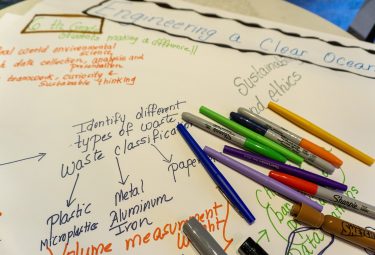Early bird rates are available for registration to the 2026 January ESIP Meeting. Register.
3 Take-Aways From Our First Remote Meeting
And how we are preparing for the 2021 Winter Meeting
By: Susan Shingledecker
—–
Every year since 1998 Earth Science Information Partners (ESIP) has met twice annually, in person. A hallmark of ESIP meetings is the collaborative, interactive and engaging sessions and the vibrant community that has formed as a result. ESIP’s work throughout the year is remote. Additionally, ESIP has long hosted hybrid meetings, streamed and/or recorded all meeting content long before this was the norm. All of these practices laid a foundation for our community to pivot in 2020 as a result of COVID-19 to remote meetings. It wasn’t perfect or easy and we still have a lot to learn to stay current with emerging trends in remote facilitation and virtual meetings.
In March 2020 ESIP’s Board made the decision that both the 2020 ESIP Summer Meeting and our upcoming 2021 ESIP Winter Meeting would be held remotely. Knowing we were looking at virtual meetings at least twice, The ESIP staff and leadership wanted to make sure that we invested in our collaborative infrastructure and formal evaluation. The evaluation of the 2020 Summer Meeting found that 94% of attendees were happy with the remote meeting and many made connections – success! Because the reactions to the format were generally positive, many community members have already become familiar with our online platforms, and significant staff transition (50% new team members!), we are planning to keep as much of the meeting infrastructure and format as consistent as possible from the 2020 Summer Meeting to the 2021 Winter Meeting.
Following our own model of asking each meeting session to provide three key take-aways, here are three lessons learned from the Summer Meeting and how we are continuing to build on this for the 2021 ESIP Winter Meeting.
1 Keep it simple and supported.
It is easy to be overwhelmed by the number of available tools, communication channels and content available as well as the amount of work it takes to plan and produce a remote meeting.
We kept it simple and supported in three ways:
- We invested in the meeting platform and tools. This summer we utilized tools that we had used at our in-person meetings like CVent, Sched and Google Docs for consistency of registration and schedule. We added Qiqochat and Zoom as the “meeting venue.”
- We invested in session conveners and in the overall meeting design utilizing meeting facilitators. To ensure that everyone was supported, we invested in significant training for our session conveners and for attendees and ESIP staff and Community Fellows provided technical support during the sessions.
- We invested in learning from the meeting with a formal, external evaluator who observed sessions, had 1-on-1 interviews, conducted a mid and final survey and held two focus groups.
For the Winter Meeting we will try to further streamline the tools so that the schedule and the venue are cohesive and easy for attendees to navigate. We also know that we over communicated at the start of the ESIP Summer Meeting, so we are going to review our communication strategy (and which tools automatically communicate) to make sure that you are not overwhelmed by all the notifications. We are building upon the training offered to session conveners to continue to improve the quality of sessions and we will again provide training and support to attendees as they become familiar with the ESIP remote meeting tools. ESIP staff will be in all sessions to alleviate any tech stress and allow the session conveners to focus on content. Another way we offer support is by recording all sessions for participants, if you can’t make it live.
2 Keep it short.
Coming into the Summer Meeting we knew that we would not be able to have 8 hours of content each day. We scaled back, which was a good move, and most days had 4.5 hours of content and 1.5 hours of breaks. However, the ESIP Summer Meeting is always about one day longer than the ESIP Winter Meeting. Because we didn’t want to cut any content that had been contributed, we spread the meeting content over two weeks with three days of planned sessions each week and Fridays were for less formal networking with the Research Showcase and FUNding Friday. From our evaluation results and the feedback we received informally, two weeks was too long and more than 4.5 hours was too much. Our attention spans working remotely are much different than the energy that is present at an in-person meeting – lesson learned.
For the Winter Meeting, the meeting will be 3.5 days starting on Tuesday, January 26 at 11am EST and ending on Friday afternoon January 29. Following the Winter Meeting, ESIP’s 22 active collaboration areas will kick off with their monthly calls to continue the work and the conversations. We design ESIP to be an active community 365 days a year. While the Winter and Summer Meetings are highlights for many in our community – we are resisting packing all ESIP has to offer into these two opportunities!
3 Keep it Meaningful.
One thing people say over and over in ESIP post-meeting evaluations is ‘This is where I found my people.’ or ‘Highly skilled people who are a good sounding board for ideas.’ 92% say that they formed collaborations with other meeting attendees, so this was critical to identify ways of supporting connections. However, in our early research of other remote events, we had the experience that while there were 800 or 1000 people online together, connections were not being made.
What we are most proud of is that ESIP Summer Meeting attendees made connections, with most reporting between two and five new connections. We cultivated meaningful opportunities to connect using Liberating Structures and other simple techniques, like the speed networking through the Research Showcase and small group email introductions that allowed attendees to virtually stumble upon interesting content and individuals.
For the Winter Meeting, we are continuing to identify new ways to build connections and to deliver meaning. This will not be a one-way webinar. As hard as it may be, we encourage you to “Block the Week” on your calendar to allow you to be fully present with us. We know that is challenging with many competing demands on your time and attention. Browse the agenda and identify the content that is ‘not to miss’ for you and to stay open to new content through the plenary sessions and networking events. The ESIP team is putting extra attention on the social side of the meeting with a virtual happy hour and multiple interactive coffee breaks. This was identified as the greatest area for improvement from the Summer meeting. We are working on the design and we ask you to show up with your ESIP friends old and new to bring it to life. It takes a bit of extra work to make remote connections, but I guarantee the reward is great when it works and our team will do all we can to support that.
Join us for the 2021 ESIP Winter Meeting
We learned so much more than this from the evaluation than we can share here. We appreciate David Reider and his team from Education Design, for their evaluation. The full evaluation is available here. We also appreciate all the Summer Meeting attendees that gave us their feedback and were willing to experiment and learn with us.
ESIP is focused in 2021 on Leading Innovation in Earth Science Data Frontiers. ESIP is on the frontier of collaborating in remote meetings and together, we are figuring out how to successfully, remotely meet, connect and work.
We are just a little more than 2 weeks until the 2021 ESIP Winter Meeting and there is still time to register! The agenda is full of leading edge innovation in Earth science data and informatics. Each day will offer engaging content and opportunities to connect. What do you get from registering? First access to this content and the opportunity to engage in real-time with this community of experts in a supported, meaningful and (fairly) short burst. Hope to see you there!



